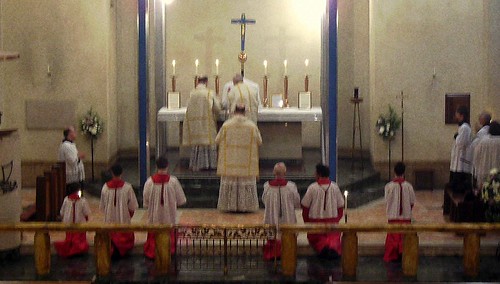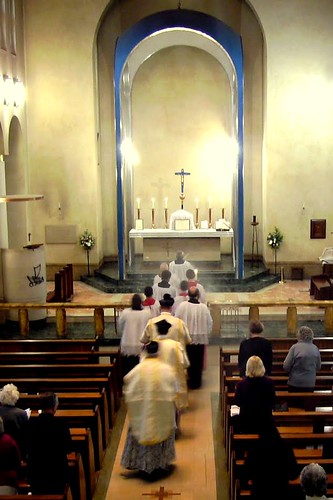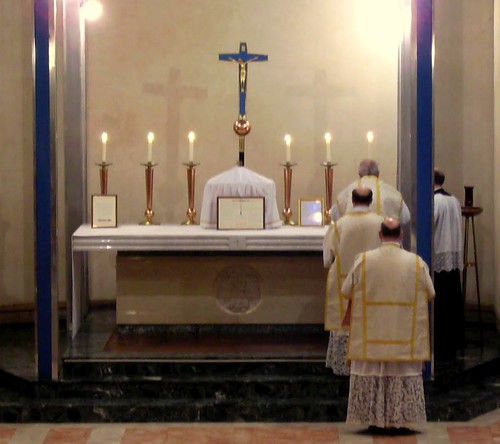
On Tuesday evening we had a High Mass at St John Fisher in West Heath. Mr Oliver Hayes, who sung in the choir for this Mass, kindly wrote a report of it on his blog along with some photos which I shall borrow. It was the second High Mass arranged at West Heath, with the first being in July this year.
Dolorósa et lacrimábilis es, Virgo María, stans juxta crucem Dómini Jesu Fílii tui Redemptóris. V. Virgo Dei Génitrix, quem totus non capit orbis, hoc crucis fert supplícium auctor vitae factus homo.
 Thou art sorrowful and tearful, O Virgin Mary, standing at the cross of the Lord Jesus, thy Son, our Redeemer. V. O Virgin Mother of God, He whom the whole world doth not contain, beareth this punishment of the cross; He the author of life made man.
Thou art sorrowful and tearful, O Virgin Mary, standing at the cross of the Lord Jesus, thy Son, our Redeemer. V. O Virgin Mother of God, He whom the whole world doth not contain, beareth this punishment of the cross; He the author of life made man.
 Thou art sorrowful and tearful, O Virgin Mary, standing at the cross of the Lord Jesus, thy Son, our Redeemer. V. O Virgin Mother of God, He whom the whole world doth not contain, beareth this punishment of the cross; He the author of life made man.
Thou art sorrowful and tearful, O Virgin Mary, standing at the cross of the Lord Jesus, thy Son, our Redeemer. V. O Virgin Mother of God, He whom the whole world doth not contain, beareth this punishment of the cross; He the author of life made man.The feast of the Seven Dolours of the Blessed Virgin Mary, now known as "Our Lady of Sorrows" in the Ordinary Form, was first held in the 17th century by the Servites. Later, in 1817, it was extended to the whole Church by Pope Pius VII to mark his own deliverance from exile and captivity, through the intercession of the Blessed Virgin. It is therefore as much a feast about our own sufferings, and how these can be united to the Cross of our Lord, in emulation of our Lady's cooperation with humanity's redemption. Redemptive suffering is, therefore, a great thing for us. Without it, suffering can seem empty and pointless, and will almost certainly lead to complete despair.
 On watching Mel Gibson's The Passion of the Christ, my own mother struggled to comprehend how our Lady could be present for our Lord's final trials and sufferings. The raw intensity of it all, the complete all encompassing grief. My mother has been through the grief of losing a son, and so she knows how intense the loss can be, let alone the extended agony of such a painful death. Imagine also, the seven sorrows set alongside our Lady's whole life: not just the four sorrows of watching our Lord's Passion, but also the sorrows during His infancy: the Prophecy of Simeon predicting the sword that would pierce her heart; the flight into Egypt to escape mass child genocide; and the loss of Jesus in the Temple of Jerusalem for three days. We can see in all these things shadows of both the Old Testament, like the slavery of the Israelites and their eventual liberation, and the future with our Lady's pain and anguish at both the crucifixion, and the three day disappearance of our Lord following His death. Suffering in all these contexts are not meaningless: They purify, perfect and give way to a resurrected life.
On watching Mel Gibson's The Passion of the Christ, my own mother struggled to comprehend how our Lady could be present for our Lord's final trials and sufferings. The raw intensity of it all, the complete all encompassing grief. My mother has been through the grief of losing a son, and so she knows how intense the loss can be, let alone the extended agony of such a painful death. Imagine also, the seven sorrows set alongside our Lady's whole life: not just the four sorrows of watching our Lord's Passion, but also the sorrows during His infancy: the Prophecy of Simeon predicting the sword that would pierce her heart; the flight into Egypt to escape mass child genocide; and the loss of Jesus in the Temple of Jerusalem for three days. We can see in all these things shadows of both the Old Testament, like the slavery of the Israelites and their eventual liberation, and the future with our Lady's pain and anguish at both the crucifixion, and the three day disappearance of our Lord following His death. Suffering in all these contexts are not meaningless: They purify, perfect and give way to a resurrected life. So back to the Feast! You'd think with all this talk of suffering there would be black vestments?! Well, no: white vestments show the glory of our Lady's suffering and the rejoice we have in her intercession and sharing in our grief. Truly we have a wonderful advocate who shares in the sufferings of Christ's spouse, His Church. This feast is just a day after the second anniversary of Summorum Pontificum: Pope Benedict XVI's Motu Proprio which by his own initiative freed the ancient Roman liturgy from restricted use. We have certainly come a long way in a short time. A High Mass in a parish church was unusual at any time, even before the Second Vatican Council. What a treat to therefore have everyone come together to make it possible.
So back to the Feast! You'd think with all this talk of suffering there would be black vestments?! Well, no: white vestments show the glory of our Lady's suffering and the rejoice we have in her intercession and sharing in our grief. Truly we have a wonderful advocate who shares in the sufferings of Christ's spouse, His Church. This feast is just a day after the second anniversary of Summorum Pontificum: Pope Benedict XVI's Motu Proprio which by his own initiative freed the ancient Roman liturgy from restricted use. We have certainly come a long way in a short time. A High Mass in a parish church was unusual at any time, even before the Second Vatican Council. What a treat to therefore have everyone come together to make it possible.Rev Fr George Grynowski, the Parish Priest at St John Fisher, has recently returned from the LMS priest's Training Conference at London, Colney. Before this he had filled the ministry of Deacon and Sub-deacon at a High Mass (in fact, he was a 'permanent deacon' up until a few years ago!). This Mass was not only his first High Mass as celebrant, but was also his first public Extraordinary Form Mass celebrated altogether. He had good help with Rev Fr Anton Guziel as Deacon, Rev Fr Christopher Miller as Sub-Deacon, and an excellent MC.
 We had so many servers willing to assist, including six from the parish itself, that we had a full complement. This meant we had six torch-bearers and a cross-bearer (who was the grandfather of one of the lads, and remembers the Latin Mass well)! These 'home-grown' servers can be seen in their red cassocks. It is an important function of the LMS, especially since Summorum Pontificum, to not merely keep the old Mass going, but to train up a new generation of faithful who get involved. I am grateful for this traditio, and am happy to now do my part to carry it on.
We had so many servers willing to assist, including six from the parish itself, that we had a full complement. This meant we had six torch-bearers and a cross-bearer (who was the grandfather of one of the lads, and remembers the Latin Mass well)! These 'home-grown' servers can be seen in their red cassocks. It is an important function of the LMS, especially since Summorum Pontificum, to not merely keep the old Mass going, but to train up a new generation of faithful who get involved. I am grateful for this traditio, and am happy to now do my part to carry it on. The choir did remarkably well, only consisting of four male voices who filled the whole church with great gusto. St John Fisher, although a modern 60s contruction, was built with the old liturgy firmly in mind, and has excellent acoustics as well. Perhaps this is also due to the lack of carpeting, which in the sanctuary was particularly hard on the torch-bearer's knees! Gregorian Chant is something which also needs to be passed on and preserved, and therefore I would be excited to hear from anyone who would be interested in learning it, or anyone willing to sing for us.
The choir did remarkably well, only consisting of four male voices who filled the whole church with great gusto. St John Fisher, although a modern 60s contruction, was built with the old liturgy firmly in mind, and has excellent acoustics as well. Perhaps this is also due to the lack of carpeting, which in the sanctuary was particularly hard on the torch-bearer's knees! Gregorian Chant is something which also needs to be passed on and preserved, and therefore I would be excited to hear from anyone who would be interested in learning it, or anyone willing to sing for us.With all this said, there were probably half the number of faithful present compared with our first High Mass here. Still, sixty was a good number by any measure. Perhaps this is due to the nights drawing in, or perhaps the initial interest has given way to indifference. Things will settle down now in West Heath. Fr George will have the opportunity to see how his parish has reacted to the ancient liturgy, and will begin also saying Low Masses. The first of these will be Wednesday October 7th at 7pm for the feast of Our Lady of the Rosary.


2 comments:
The 1962 missal title for the feast is Septem Dolorum B.M.V. which is exactly the same as in old rite missals.
So whilst there were many other changes in the 1962 missal a change of title for this feast was not one of them.
I stand corrected and have amended my remark. I was getting confused having read the change of name for "The most holy Rosary" to "Our Lady of the Rosary"!
Post a Comment